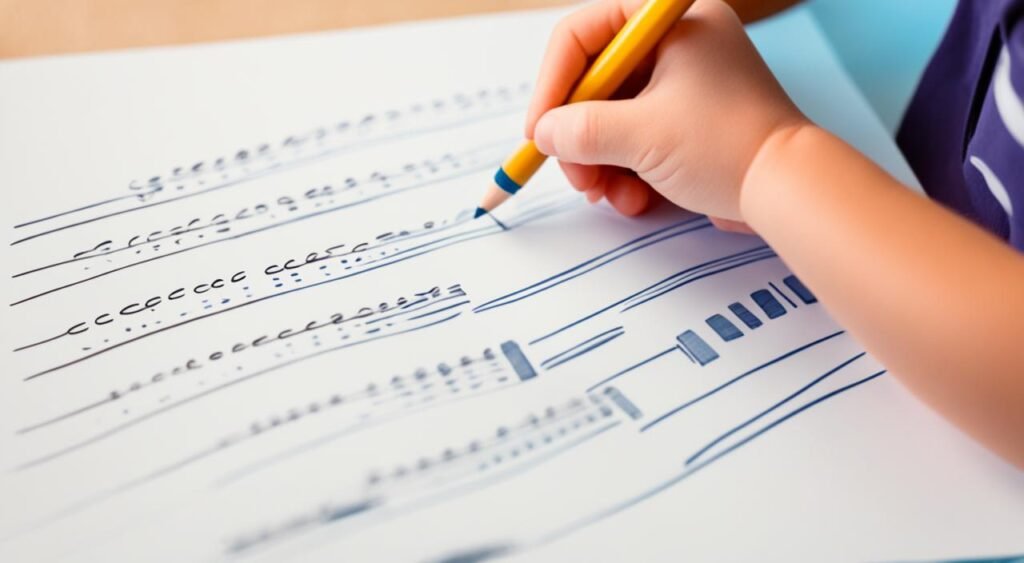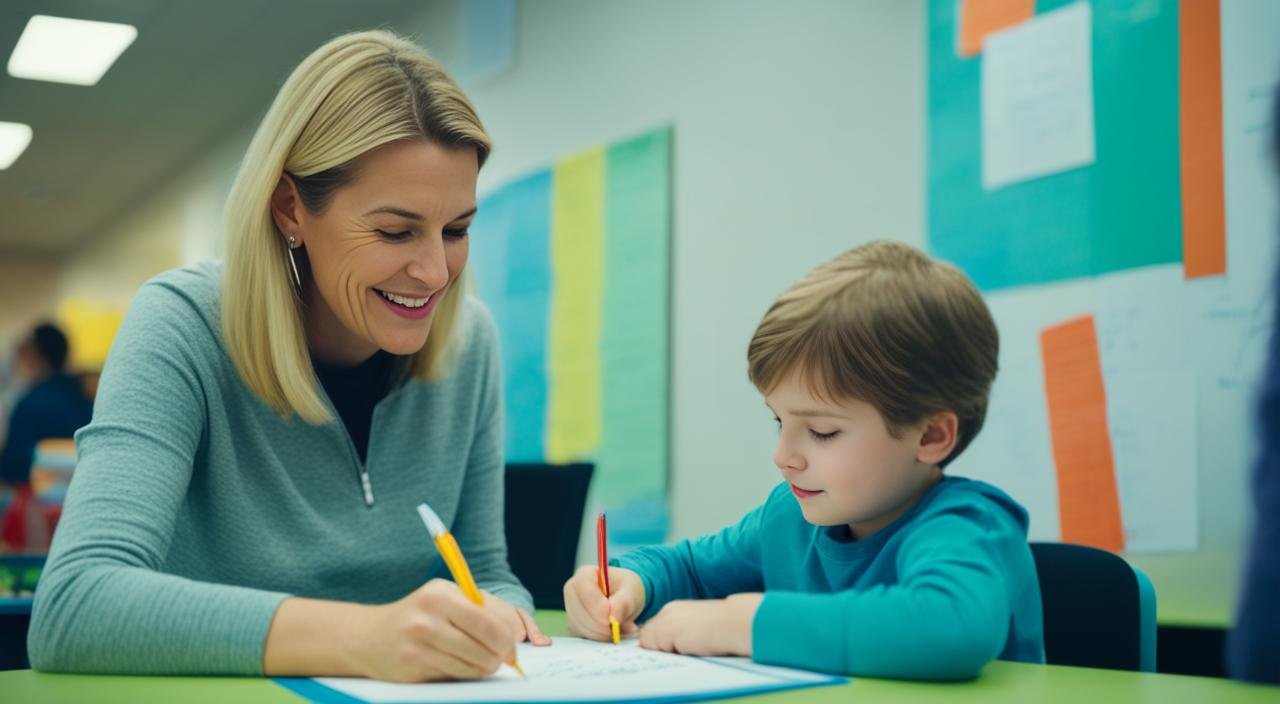Dysgraphia is a learning disability that affects a child’s ability to write. It can be frustrating and challenging for both the child and their parents. However, there are several strategies and tips that can help children with dysgraphia improve their writing skills.
These strategies include sensory activities, large motor movements, fine motor exercises, cross-body training, and practicing storytelling with a clear structure. By implementing these strategies and providing the necessary support, parents and caregivers can help their child with dysgraphia thrive academically and emotionally.
Key Takeaways:
- Understanding dysgraphia in children and its impact on writing abilities
- Implementing sensory activities to engage senses and enhance learning
- Utilizing fine motor exercises to improve finger strength and dexterity
- Exploring alternative writing methods, such as cursive or typing
- Offering dysgraphia accommodations and support in school settings
Sensory Activities for Dysgraphia
Sensory activities are a valuable tool for helping children with dysgraphia improve their writing skills. These activities focus on engaging the senses to enhance learning and retention, making the writing process more enjoyable and effective for dyslexic children. By incorporating sensory activities into a child’s routine, parents and educators can provide them with a multisensory learning experience that can greatly benefit their writing abilities.
Feeling Letters for Dysgraphia
One effective sensory activity for dysgraphic children is feeling letters on their back. This activity helps them develop a tactile understanding of letter formations, promotes muscle memory and enhances proprioceptive skills. Parents or educators can guide the child’s finger to trace each letter on their back, allowing them to feel the shape and movement of the letters while also visualizing them in their mind.
To facilitate this activity, you can use large, textured letters, either made of foam or fabric, that can be easily held and traced. The child can explore different letters in a relaxed and supportive environment, allowing them to build connections between the feel of the letter and its written representation.
Writing Big for Dysgraphia
Another effective sensory activity is writing big with materials such as shaving cream or sand. This activity engages multiple senses, including touch and sight, while also promoting gross motor movements. By providing the child with a large writing surface and encouraging them to use big movements, they can develop a better understanding of letter formations and improve their overall writing skills.
To engage in this activity, you can spread a layer of shaving cream or sand on a tray or table and ask the child to use their finger or a writing tool to write large letters or words. The child can experiment with different writing techniques and discover the sensory feedback associated with each stroke. This activity not only enhances their fine motor skills but also allows for free and creative expression.
Clay Therapy for Dysgraphia
Working with clay is another beneficial sensory activity for dysgraphic children. By manipulating and shaping clay, they can develop hand strength, dexterity, and coordination, which are essential for improved writing skills. Clay therapy helps children build their fine motor skills while engaging their tactile senses, providing an enjoyable and effective way to strengthen their hands and fingers.
During clay therapy sessions, children can explore different shapes, textures, and patterns, promoting creative thinking and spatial awareness. They can also practice forming letters or words with clay, allowing them to experience the physical movements associated with writing in a more tactile and engaging manner.
Pinching Skills for Dysgraphia
Pinching skills exercises can also benefit children with dysgraphia by improving their finger strength and coordination. These exercises focus on pinching and manipulating small objects, allowing the child to refine their fine motor skills and develop better control over their writing utensils.
Some examples of pinching skills exercises include using tweezers to pick up small objects, manipulating playdough or putty, or using clothespins to pick up and move items. These activities engage the child’s muscles and sensory receptors, promoting precision and control in their hand movements, which can significantly enhance their handwriting abilities.
Cross-Body Training for Dysgraphia
Cross-body training exercises can help dysgraphic children improve their coordination and motor planning, which are essential for fluid and efficient writing skills. These exercises involve movements that cross the midline of the body, stimulating both sides of the brain and promoting better communication between them.
Some cross-body training exercises that can benefit dysgraphic children include activities like marching while touching opposite knees with their elbows, crossing one foot over the other while seated, or performing windmill arm movements that cross the body’s midline. By incorporating these exercises into a child’s daily routine, they can develop better coordination and spatial awareness, which translate into improved writing abilities.
Building Strength and Stability for Dysgraphia
Building overall strength and stability is an essential aspect of improving writing skills for dyslexic children. Engaging in physical activities that target core strength, balance, and posture can help them maintain a proper writing position and reduce fatigue during writing tasks.
Activities such as yoga, balancing exercises, or using stability balls can promote muscle development and improve body awareness. By encouraging the child to participate in regular physical activities, parents and educators can support their overall well-being and help them develop the strength and stability needed for more comfortable writing.
Fine Motor Exercises for Dysgraphia
Fine motor exercises are essential for children with dysgraphia, as they help improve their handwriting skills. These exercises specifically target the development of finger strength, dexterity, and endurance, all of which are crucial for proficient writing. By incorporating these exercises into a child’s routine, their fine motor skills can be enhanced, leading to improved handwriting abilities.
Some effective fine-motor exercises for dysgraphia include:
- Working with clay or putty: This helps strengthen the muscles in the fingers and promotes better control and precision.
- Playing with resistive toys: Squeezing stress balls or using squeeze toys can help improve grip strength and coordination.
- Using adaptive writing tools, such as pencil grips and ergonomic pens, can assist in proper finger positioning and reduce strain during writing.
Selecting the right paper for writing is also crucial for children with dysgraphia. Choosing paper with wider lines or specialized handwriting paper with guide lines can make it easier for them to form letters and maintain consistent sizing.
In addition, incorporating multisensory approaches in writing activities can facilitate learning for children with dysgraphia. Writing on different mediums, such as sand, rice, or textured surfaces, can engage multiple senses and enhance sensory integration, helping children overcome sensory issues and improve their writing.
A supportive writing environment is equally important in building visual skills and fostering confidence in children with dysgraphia. Creating a well-lit workspace with adequate writing tools and a comfortable seating position can enhance their focus and overall writing experience.
By implementing these fine motor exercises, choosing appropriate writing tools and paper, and incorporating multisensory approaches, parents and caregivers can provide children with dysgraphia the support they need to improve their handwriting skills and overcome challenges associated with dysgraphia.
Transitioning to Cursive Writing and Alternative Writing Methods

For children with dysgraphia, transitioning to cursive writing can be a viable solution to improve their writing skills. Cursive writing involves continuous strokes, which can be easier for dysgraphic children to master compared to print. It provides a natural flow and reduces the need for frequent pencil lifts, minimizing the frustration caused by letter formations. By transitioning to cursive writing, children with dysgraphia can develop a more efficient writing style, enhance their legibility, and improve their overall confidence in expressing themselves through writing.
Alternatively, alternative writing methods, such as typing, can also benefit children with dysgraphia. Typing allows them to bypass the physical demands of handwriting, allowing them to focus more on the content and organization of their thoughts. With proficiency in touch typing, dysgraphic children can achieve faster and more accurate written communication. They can also utilize assistive technologies like speech-to-text or word processors, which can further support their writing process and enhance their productivity.
Another effective technique for dysgraphic children is narration. By verbalizing their thoughts and dictating their ideas, children can bypass the physical challenges associated with writing. Narration helps them practice organizing their thoughts and expressing them in a coherent manner. This method encourages creativity, as children can focus solely on the content without being hindered by the mechanics of handwriting.
Large-air writing techniques can also be beneficial for dysgraphic children. This technique involves using their hands and arms to simulate writing movements in the air. By doing so, they can develop motor memory for letter formations and improve their overall writing abilities. This technique not only enhances their muscle memory but also provides a multisensory experience that aids in retaining information.
Pros and Cons of Cursive Writing and Alternative Methods
| Transitioning to Cursive Writing | Alternative Writing Methods |
|---|---|
| Easier for dysgraphic childrenNatural flow and continuous strokes can improve legibility and confidence | Bypass physical demands of handwritingImproved focus on content and organizationUtilize assistive technologies |
| Narration | Large-Air Writing Techniques |
| Bypass physical challenges of writingEnhances organization and expression skillsAllows focus on content without handwriting mechanics | Develops motor memory for letter formationsImproves overall writing abilitiesProvides a multisensory experience |
When considering transitioning to cursive writing or alternative writing methods for a child with dysgraphia, it is important to weigh the advantages and disadvantages. Every child is unique and may respond differently to different approaches. It may be beneficial to consult with educators, occupational therapists, and other specialists who can provide personalized guidance and recommendations based on the child’s specific needs and abilities.
Conclusion
Helping a child with dysgraphia improve their writing skills requires a combination of strategies, patience, and support. By understanding the challenges associated with dysgraphia and implementing sensory activities, fine motor exercises, alternative writing methods, and supportive tools, parents and caregivers can make a significant difference in the child’s learning experience.
It is important to remember that each child is unique and may require individualized approaches. The key is to provide a supportive and nurturing environment where the child can feel empowered to overcome their writing challenges. With the right interventions and consistent practice, children with dysgraphia can develop and enhance their writing skills, boosting their confidence and academic success.
By embracing their unique strengths and finding innovative ways to overcome difficulties, children with dysgraphia can thrive both academically and emotionally. With the support of their parents, caregivers, and educators, they can cultivate a love for writing and achieve their full potential.
FAQ
How can I help a child with dysgraphia improve their writing skills?
There are several strategies that can help children with dysgraphia improve their writing skills. These include sensory activities, fine motor exercises, transitioning to cursive writing, and alternative writing methods such as typing or using assistive technologies.
What are some sensory activities that can benefit a child with dysgraphia?
Sensory activities such as feeling letters on the back, writing big with shaving cream or sand, working with clay, practicing pinching skills, and engaging in cross-body training exercises can help improve a child’s writing skills.
What are fine motor exercises and how can they help with dysgraphia?
Fine motor exercises focus on building finger strength, dexterity, and endurance. Activities such as using clay or putty, playing with resistive toys, using adaptive writing tools like pencil grips, and selecting the right paper for writing can improve a child’s handwriting skills.
Is transitioning to cursive writing helpful for children with dysgraphia?
Yes, for some children with dysgraphia, transitioning to cursive writing can reduce frustration and improve writing skills. Cursive writing involves continuous strokes and can be easier for dysgraphic children to master compared to print.
Are there alternative writing methods that can help children with dysgraphia?
Yes, alternative writing methods such as typing or using assistive technologies like speech-to-text or word processors can provide relief from the physical demands of handwriting and allow dysgraphic children to focus more on expressing their thoughts and ideas.





